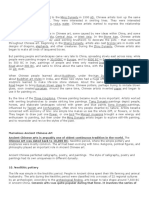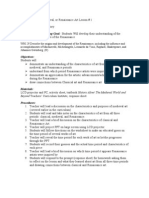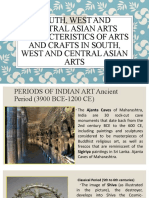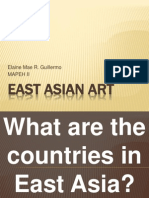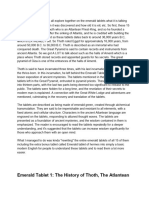Arts of East Asia
Arts of East Asia
Uploaded by
Bella StellinaCopyright:
Available Formats
Arts of East Asia
Arts of East Asia
Uploaded by
Bella StellinaOriginal Description:
Copyright
Available Formats
Share this document
Did you find this document useful?
Is this content inappropriate?
Copyright:
Available Formats
Arts of East Asia
Arts of East Asia
Uploaded by
Bella StellinaCopyright:
Available Formats
East Asian arts
i Help us expand this topic. Submit Contribution
Images Videos
East Asian arts, the visual arts, performing arts, and music of China, Korea (North Korea and South Korea), and Japan. (The literature of this region is treated in separate articles on Chinese literature, Korean literature, and Japanese literature.) Some studies of East Asia also include the cultures of the Indochinese peninsula and adjoining islands, as well as Mongolia to the north. The logic of this occasional inclusion is based on a strict geographic definition as well as a recognition of common bonds forged through the acceptance of Buddhism by many of these cultures. China, Korea, and Japan, however, have been uniquely linked for several millennia by a common written language and by broad cultural and political connections that have ranged in spirit from the uncritically adorational to the contentious. A broad introduction to East Asian artstheir common characteristics, traditions, and values follows. More detailed and focused treatment is presented elsewhere. For detailed coverage of the visual art of East Asia, see Chinese art; Chinese bronzes; Chinese calligraphy; Chinese jade; Chinese lacquerwork; Chinese painting; Chinese pottery; Japanese art; Japanese calligraphy; Japanese pottery; Korean art; Korean calligraphy; and Korean pottery. For detailed coverage of the architecture of East Asia, see Chinese architecture; Japanese architecture; and Korean architecture. For detailed coverage of the music of East Asia, see Chinese music; Japanese
music; and Korean music. Likewise, for detailed coverage of the dance and theatre of East Asia, see Chinese performing arts; Japanese performing arts; and Korean performing arts.
The visual arts
From ancient times, China has been the dominant and referential culture in East Asia. Although variously developed Neolithic cultures existed on the Korean Peninsula and on the Japanese archipelago, archaeological evidence in the form of worked stone and blades from the Paleolithic and Neolithic periods suggests an exchange between the early East Asian cultures and the early introduction of Chinese influence. This cultural interaction was facilitated in part by land bridges that connected Japan with the continent.
Significant developments in the production of earthenware vessels from as early as 14,000 bce in Japan (thus far, the worlds earliest dated pottery) and from approximately 3500 bce in Korea are well documented. They reveal a rich symbolic vocabulary and decorative sense as well as a highly successful union of function and dynamic form. These types of vessels chronicle the increasing needs for storage as there was a gradual societal transformation from nomadic and foraging cultures to more sedentary crop-producing cultures. There were pottery-dominant cultures in China as well. The painted (c. 5000 bce) and black (c. 2500 bce) earthenware are the best known. As Korea and Japan continued in various Neolithic phases, developments in China from approximately 2000 bce were far more complex and dramatic. Archaeological evidence firmly corroborates the existence of an emerging bronze culture by approximately 2000 bce. This culture provided the base for Shang dynasty (c. 16001046 bce) culture, which witnessed extraordinary developments in the production of bronze, stone, ceramic, and jade artifacts as well as the development of a pictograph-based written language. Bronze production and the expansion of rice cultivation gradually appeared in Korea from approximately 700 bce and then slightly later in Japan. While no single political event seemed to further the transmission of Chinese cultural elements to Korea and Japan, clearly the expansionist policies of the rulers of the Han dynasty (206 bce220 ce) stimulated what had been a gradual assimilation of Chinese cultural elements by both Korea and Japan. Indicatively, it is from this period that Chinese
documentation of legation visits to Japan provide the first written records describing the structure of Japanese society. The cultures of China, Korea, and Japan went on, from this period of interaction during the Han dynasty, to develop in quite distinctive ways. China, for example, experienced two major dynasties, the Han and the Tang (618907), that were truly international in scope and easily rivaled contemporary Mediterranean powers. In succeeding dynasties, including rule by foreign invaders from the north, the development of the visual arts continued to explore and develop the basic media for which the Chinese demonstrated special affinity: clay, jade, lacquer, bronze, stone, and the various manifestations of the brush, especially in calligraphy and painting. Emphases shifted, as did styles, but the fundamental symbolic vocabulary and a predisposition to renew through reinterpretation and reverence of the past was characteristic not only of Chinese arts but of all the East Asian arts.
Koreas pivotal location gave it particular strategic value and thus made it the target of subjugation by a stronger China and Japan. But Korea strove to maintain its own identity and to prevent China and Japan from exercising control over more than a small portion of the peninsula. National contributions to the larger aesthetic culture of East Asia included unequaled mastery of goldsmithing and design as well as a ceramic tradition that included delicate celadon ware and a vigorous folk ware that inspired generations of Japanese tea masters. Indeed, Korea was a primary conduit of continental culture to the Japanese in many areas of visual expression, including metalwork, painting, and ceramics.
In the late 13th century, Mongol forces made two unsuccessful attempts at invading the Japanese islands, and the country was spared occupation by a foreign power until well into the 20th century. This unusual condition of comparative isolation provided Japanese cultural arbiters with a relative freedom to select or reject outside styles and trends. Nevertheless, Chinese arts highly developed, systematic forms of expression, coupled with its theoretical basis in religion and philosophy, proved enormously forceful, and Chinese styles dominated at key junctures in Japanese history. The reception and assimilation of outside influence followed by a vigorous assertion of national styles thus characterized the cycle of Japanese cultural development. In addition to distinctive reinterpretations of Chinese ink monochrome painting and calligraphy, an indigenous taste for the observation and depiction of human activity and an exquisitely nuanced sense of design are readily apparent in most areas of Japanese visual expression, none more so than in narrative painting and in the wood-block print.
The elements and tendencies common to the Chinese, Korean, and Japanese cultures are vast, but two kinds of visual expression are especially important: a strong affinity for the clay-formed vessel and calligraphic expression through the ink-charged brush. Vigorous, subtle, and technically sophisticated expressions ranging from Neolithic earthenware to celadon and glazed enamelware were both integral to daily life and prized by connoisseurs who judged ceramics by an elaborate code of appreciation. Increasingly abstracted forms of pictographs provided a means of writing that was image-based; characters formed by the brush could be normative but also offered infinite possibilities for personal expression through ink modulation and idiosyncratic gesture. Although Korea and Japan later developed phonetic syllabaries, the visual language of the educated continued to be based on the ancestral Chinese form. The meanings of words, phrases, or whole texts could be expanded or nuanced by their visual renderings. Painting was derivative from calligraphy, and implicit in painting skill was a preceding mastery of the brushrendered calligraphic line. As a consequence, calligraphy was unequaled as the major element in the transmission of cultural values, whether as information or as aesthetic expression. The influence of Buddhism, a force which was initially foreign to East Asia, also should not be underestimated. Emerging from India and Central Asia in the first century after nearly 500 years of development on the subcontinent, Buddhism offered a convincing universalist system of belief that assimilated and frequently gave visual expression to indigenous religions. By the 5th century ce, a Chinese dynastic line had adopted Buddhism as a religion of state. While individual rulers, courts, or dynasties at times propelled the florescence of East Asian arts, none of them equaled the patronage of Buddhism in duration, scale, and intellectual sustenance. Confucianism, Daoism, and, to a somewhat lesser degree, Shint required expression through the arts; however, Buddhisms multiple sects, complex iconography, and program of prosel ytizing made it the natural and dominant vehicle of transcultural influence in East Asia.
The performing arts
From ancient times dance and theatre have played a vital role in China, Korea, and Japan. Many performances of plays and dances were closely tied to religious beliefs and customs. In China, records from about 1000 bce describe magnificently costumed male and female shamans who sang and danced to musical accompaniment, drawing the heavenly spirits down to earth through their performance. Impersonation of other characters through makeup and costume was occurring at least by the 4th century bce. Many masked dances in Korea have a religious function. Performances invoking Buddhas protection are especially popular and numerous in Japan and Korea. Throughout East Asia the descendants of magico-religious performances can be seen in a variety of guises. Whether designed to pray for longevity or for a rich harvest or to ward off disease and evil, the rituals of impersonation of supernatural beings through masks and costumes and the repetition of rhythmic music and patterns of movement perform the function of linking humans to the spiritual world beyond. Hence, from the earliest times in East Asia, dance, music, and dramatic mimesis have been naturally fused through their religious function. In East Asia the easy intermingling of dance and theatre, with music as a necessary and inseparable accompanying art, also derives from aesthetic and philosophic principles. In the West, by contrast, musical performance, spoken drama, and ballet have evolved as separate performing arts. Confucian philosophy holds that a harmonious condition in society can be
produced by proper actions, including the playing of music and the performance of dances that are appropriate and conducive to moderation. Throughout Chinas history, poems were written to be sung; songs were danced. Dancing, while it might occasionally be pure dance without meaning, more often was used to enact a story in the theatre. Zeami (13631443), the most influential performer and theoretician of Noh drama in Japan, described his art as a totality, encompassing mimesis, dance, dialogue, narration, music, staging, and the reactions of the audience as well. Without arbitrary divisions separating the arts, East Asia has developed exceptionally complex artistic forms possessing extraordinary richness and subtlety. Dance may be dramatic or nondramatic; in all traditional theatre forms some elements of dance will be found. Puppets, masks, highly stylized makeup, and costuming are common adjuncts of both dance and theatre. Dialogue drama (without music) is rare but does exist. The major dance and theatre forms performed today in East Asia can be loosely classed as unmasked dances (folk and art dances in each country), masked dances (Korean masked dances and bugaku and folk dances in Japan), masked dance theatre (Noh in Japan and sandae in Korea), danced processionals (gyd in Japan), dance opera (jingxi and other forms of Chinese opera), puppet theatre (kkoktukaksi in Korea and Bunraku in Japan), shadow theatre (in China), dialogue plays with traditional music and dance (Kabuki in Japan), dialogue plays with dance (kygen in Japan), and modern, realistic dialogue plays introduced from the West into China, Korea, and Japan in the 19th and 20th centuries.
Common traditions
As previously noted, China, Korea, and Japan have been historically close for centuries, thus accounting for their numerous common artistic traditions. From pre-Christian times until the 8th and 9th century ce, the great trade routes crossed from the Middle East through Central Asia into China. Hinduism, Buddhism, some knowledge of ancient Greek, and much knowledge of Indian arts entered into China, and thence in time into Korea and Japan. Perhaps before the Common Era, the Central Asian art of manipulating hand puppets was carried to China. For more than 700 years, until 668, in the kingdom of Kogury, embracing northern Korea and Manchuria, court music and dances from Central Asia, from Han China, from Manchuria, and from Korea, called chis and kajis, were performed. Many of the dances were masked; all were stately as befit serious court art. They were taken to the Japanese court in Nara about the 7th century. Called bugaku in Japan, they have been preserved for 12 centuries and are still performed at the Imperial Palace in Tokyo, though they have long since died out in China and Korea. In Kogurys neighbouring kingdom of Paekche, a form of Buddhist masked dance play was performed at court, and, in the 7th century, it too was taken to the Japanese court at Nara by a Korean performer, Mimaji, who had learned the dances while staying at the southern Chinese court of Wuhou. Called kiak in Korea and gigaku in Japan, the Aryan features of some of its masks clearly indicate Indian (or Central Asian) influence. Such complicated genealogies are common in East Asian performing arts.
Very likely by the 7th century, nomadic puppeteers from Central Asia who had taken up residence in northern Korea migrated to Japan. The men continued to be
both herdsmen and puppet manipulators in their new homeland, while the women performed dances and sang as popular entertainers. (There may have been a native puppet tradition in Japan as well.) In time the art of puppet manipulation joined with that of epic storytelling to produce the famous Bunraku puppet theatre. Musical accompaniment for Bunraku and for other popular plays in Japan, such as Kabuki, was provided primarily by the samisen, a three-stringed lute, borrowed from China by way of Okinawa. The lion dance, originally from China, is performed in a score of versions in Korea and Japan as well as in China, India, Sri Lanka, and Bali. Certain myths are dramatized in common as well. The story of the angel or nymph who flies down to earth and arouses the love of a mortal man is known in many parts of the world. It is dramatized in Southeast Asia (especially in Myanmar [Burma] and Thailand, as the play Manora), in Chinese opera, and in both Noh and Kabuki theatre in Japan (as Hagoromo [The Feather Robe]). The legend of the one-horned wizard who traps the dragon gods of rain and causes a searing drought originated in India and was later transmitted by the Chinese to Japan, where it is dramatized in Noh (Ikkaku sennin [The One-Horned Wizard]) and in Kabuki (Narukami [Saint Narukami and the God Fud]). The direction of artistic exchange was reversed in the 19th century. As part of Japanese national policy following the Meiji Restoration (1868), artists studied Western performing arts. In the early decades of the 20th century, Chinese and Korean actors, dancers, and playwrights studying in Japan took back to their countries Western theory and practice in ballet, modern dance, and theatre. Most influential was the Western dramatic theory of realism. It diametrically opposed the traditional intermingling of music and dance with drama, and it eschewed the stylization and symbolism that lay at the heart of East Asian performing arts for more than 2,000 years. A conflict between traditional and Western performing arts came into being that continues to the present. As has been noted, dance and theatre are accompanied by music in all except the most unusual cases. Music may be instrumental or vocal. The music is especially composed for each Bunraku puppet play in Japan and for most dance plays and court dances. Fixed melodies accompany most folk performances. In Chinese opera and in Japanese Kabuki, melodies appropriate to scene, action, character, or mood being portrayed are selected from a standard musical repertoire of several hundred tunes. The knowledgeable spectator easily identifies scenes by the music that accompanies them (a similar system is found in Southeast Asian theatre). The close linking of music with dance and theatre can be seen in the Korean drum dance, in which the dancer also is a musician who plays the drum, and in a number of Japanese Kabuki and puppet plays that show characters expressing hidden feelings by playing a musical instrument. Equally important, the performer demonstrates to the audience his skill in yet another refined accomplishment.
The performing arts of India (see South Asian arts) are closely linked to sculpture and painting by the unusual phenomenon that bodily positions in all these arts are regulated by similar, indeed almost identical, codes. The code of hand gestures, for example, for the dancer and the actor set forth in the Natya-shastra (Treatise on the Dramatic Arts; dated
variously from the 2nd century bce to the 4th century ce and later), a treatise on dramaturgy, is identical with that for Buddhist temple sculpture, or painting. Although these hand positions (mudr) from India also are seen in Chinese, Korean, and Japanese statues of the Buddha, they were not adopted by East Asian performing artists (as they were by dancers and actors in Cambodia, Thailand, Myanmar, Java, and Bali). In three notable instances, however, the performing arts in China and in Japan can be seen to be closely related to the visual arts. During the Song dynasty (9601279) in China, Northern and Southern schools of painting evolved that were totally different in style; the former used bold outline and brilliantly contrasting colours of deep green, blue, and gold, while the latter emphasized delicate, monochrome ink painting of misty landscapes. Northern and Southern schools of opera at the time reflected the same contrasting characteristics: the former dynamic, vigorous, and filled with action, the latter emphasizing wistful emotions and soft, gentle singing. Zen Buddhism was a common source of inspiration in the 15th and 16th centuries in Japan for Noh dance drama, for the tea ceremony, for ink painting, and for the art of rock-and-sand gardens. Spareness of form, discipline, and suggestion rather than explicit statement are Zen attributes found in these and other arts cultivated by the military ruling class (samurai) of the time. In 18th-century Japan, a lively and faddish urban culture produced both ukiyo-e woodblock prints and Kabuki. In fact, ukiyo-e artists, such as Tshsai Sharaku, established their fame by portraying famous Kabuki actors as their subjects. Eroticism, verve, brilliant colouring, and an intense interest in the passing moment characterize equally both Kabuki theatre and ukiyo-e visual art. Although dances were often performed to sung poems and plays either were written in verse form or contained references to classic poems, the performing arts traditionally are seen as distinct from literature in East Asia. A century and a half passed in Kabuki before the first complete play script was preserved, and in China, where a tradition of written literature dates to 1400 bce, no play text was considered worth committing to paper until the late Song, about the 13th century. With few exceptions, playwrights have rarely been accorded the same status as writers of poetry, novels, or criticism. As a result, the performing arts in East Asia succeeded by and large in escaping the stultifying grip that literature came to hold on Indian Sanskrit drama and, some would say, still holds, at least in part, on drama in the West.
The general outlines of artistic borrowings among East Asian countries can be traced from historical records. But borrowing tells only half of the story. No matter how strong the initial outside influence, in time, assimilation of the foreign art took place. Older native performing traditions reasserted themselves, and new creativity altered the borrowed elements. This can be seen even in bugaku dances in Japan; although they are believed to preserve ancient Chinese and Korean forms to a very remarkable extent, native Japanese qualities are also present. Local styles predominate even more in the popular arts. Japanese Bunraku puppet plays and Kabuki theatre show almost no observable signs of foreign influence. In spite of certain general cultural similarities, then, the dance and theatre of China, Korea, or Japan exhibit definite local characteristics not shared by the arts of their neighbouring countries.
In China singing became highly developed, and the most important theatre performances are built around song (hence the term Chinese opera). Dance as a separate art has a weak tradition there and, at least in the 20th century, was tied very closely to the theatre. The shadow theatre, known from Morocco through Egypt and Greece and in India, Indonesia, Malaysia, Thailand, and Cambodia, is found in East Asia only in China. In Korea there are scores of court and folk dances and danced plays, but no sophisticated dramatic forms evolved until the 20th century. Masked dances especially are characteristic of Korea. In Japan, from an early tradition of imported pure dance and from folk dance, complex theatrical forms evolved that include dance drama, epic narrative performed as a puppet play, and dialogue dramas either accompanied by music or not. The aesthetic principles that govern dance and theatre in East Asia are radically different from those of the West. Dancers in the West attempt to be free from the pull of the Earth, trying to leap and soar in the air. Dancers in China, Korea, or Japan stand firmly on the dance floor, often scarcely raising their feet in the air; they move in relatively slow and often geometric patterns. Arm and hand movements are important and varied, while in Western dance the hands are little used. Whether the dancers movement is dance or not, it is always stylized. Speech is stylized as well, whether it is dialogue or narration, chanted or sung. The intent may be to portray archetypes, human or mythological, especially in shadow and puppet theatre and in masked dances and plays. Form is emphasized, both for its ritual value and because audiences are trained to recognize the beauty implicit in form. There may be a purposeful contradiction between artistic ends and means: children were moved as human puppets in China, and adults acted before lighted screens to make a living shadow play; in Japan, puppets execute realistic daily actions, while live Kabuki actors refrain from duplicating daily life. The East Asian audience is prepared to respond in quick succession to a sequence of different stimuliphysical characterization, human speech, song, narrative commentary, visual composition, formal movement patternsover long periods of time, for 8 hours in Noh or up to 12 hours in Kabuki. This differs from the West, where the spectator expects to be exposed to a clearly focused theatrical image for only two or three hours. The East Asian experience is more diverse, more extended, more conventional than the Western experience in the theatre. A further important characteristic of dance and theatre in China, Korea, and Japan is that performing arts developed very largely within an oral tradition. By and large the performers themselves created the forms; only gradually did specialists in choreography, musical composition, or writing take their places in performing groups. Even after forms reached maturity, traditions of dance, acting, and music were passed on orally to the next generation. Play scripts came to be written in full only at a late date.
Social conditions
It is notable that, although some dance and theatre forms were highly regarded in China, Korea, and Japan, performers were usually looked down upon. Wandering performers especially were despised in the agrarian societies, where attachment to the land was valued and Confucian teaching, strong throughout East Asia, stressed veneration of ones parents, which included tending their graves and making offerings for their welfare in the spirit world. The place of
drama or of dance in these societies depended in part upon their audiences, whether they were court nobles, villagers, or town merchants. Chinese emperors, Korean kings, and Japanese emperors and military rulers (shoguns) all supported performers at their courts. During the Tang dynasty, the 8th-century Chinese emperor Xuanzong (also called Minghuang) established schools in the palace city of Changan (Xian) for music, dancing, and acting. The latter school was called the Pear Garden (Liyuan); ever since, actors in China have been called children of the pear garden (liyuan zidi). More than a thousand young people from all ranks of society drew government salaries while studying and performing at lavish state banquets and for official ceremonies. Acting or dancing might be a permanent job (at least until old age made one less attractive) at the Chinese court, but in Korea performers at the court held other positions in the government and were mobilized from around the country only for rehearsal and performance. In Japan, dancers and musicians have been attached to the imperial household from the 7th century until the present time. First gigaku and then bugaku dances were official performing arts, while shrine dances (kagura) were also partly under imperial patronage. The military rulers of Japan incorporated into their retinues Noh actors and musicians beginning in the 15th century, and, in time, provincial lords also began to follow this practice. Court support resulted in high artistic levels in all countries. Performers were relieved of financial problems and could devote themselves, often full-time through their entire lives, to their art. Audiences were educated and for the most part discerning. The importance attached to official performances undoubtedly spurred artists to extend themselves to their utmost. In time, however, such forms as Japanese Noh and bugaku and Chinese kunqu opera became so rarefied that they could be appreciated only by a small elite group. At the Chinese and Korean courts, young female dancers were part of the rulers personal retinue (often his concubines); they were not allowed to mix with men of the court, so that some court arts were performed solely by men and others solely by women. This custom and the consequent artistic practice of male and female impersonation is also found in court theatre of Cambodia and Thailand. In Japan, women seldom performed at court, and the major dance and theatre forms were entirely the province of male performers. Since it was unusual for rulers or courtiers themselves to take part in performance (they often did in Java, Bali, and Thailand), the court artist was usually a middle-level civil servant. Folk performers, on the other hand, are local villagers who, like the sandae masked dancers of Korea or the young women who perform festive ayakomai dances in Japan, are amateurs who do not live by their art. The midsummer Bon dance for spirits of the dead or early spring riceplanting dances in many areas of Japan or various auspicious dances held at the New Year in Korea and China were performed only once a year, and hence a high level of artistry was not usually achieved. Because many folk performances were held as part of religiously sanctioned rituals (Korean mask plays ensuring harvest, dances and dance plays of many varieties in Japan dedicated to local Shint deities), performers achieved considerable status in the local community by their participation in these essential communal rites.
Performers of popular dance and theatre in East Asia liveas do commercial artists everywhereby their ability to draw audiences who are willing to pay money for a seat in a public theatre. The shadow and puppet performers of China, jingxi actors and musicians, and Kabuki and Bunraku puppet performers in Japan are popular artists. Neither a part of village culture nor patronized by the court, they have always been held suspect by their rulers. Kabuki, in particular, was faced with repressive government action throughout most of its history. Popular theatre grew in importance in China and in Japan concurrently with the growth of large urban centres and a moneyed, mercantile economy, in the 17th19th centuries. (An important urban popular theatre did not develop in Korea.) Today troupes perform nightly throughout the year, when it is possible, and consequently, in popular theatre, large repertories of standard plays are created (some 350 in Kabuki and more than 200 in Chinese opera). Popular theatre forms in China and Japan are intensely theatrical, though they lack literary qualities that would recommend them to the intelligentsia. Indeed, Kabuki in Japan and jingxi in China have had little official status until the mid-20th century in spite of their immense audience popularity and their obvious excellence as performing arts. Traveling troupes that perform shadow or puppet plays, do acrobatics and juggling, dance and sing, and perform versions of court or popular entertainments have long been a feature of Chinese and Korean village and provincial town life. Artistically the forms are related to folk performing arts; socially the performers are considered outcasts, wandering entertainers of no status who belong to the popular tradition of performing arts. James R. Brandon
Music Table Of Contents
East Asian music vis--vis that of other major cultures
East Asia can be viewed as one of the big four among the generally urban, literate cultural areas of the world. The other three are South Asia, the Middle East, and Europe. Around each of these major regional cultures one can find many satellite musical systems known as national forms. In most cases, the fundamental musical concepts of such national forms reflect the basic ideals of the cultural core. For example, the musics of Iran and Egypt are of one family, as are those of France and Sweden or of China and Japan. A possible fifth addition to the big four concept is the Southeast Asian musical culture characterized by the use of knobbed gongs. Its documents on music theory from the 18th to the 20th century combine South and East Asian concepts with indigenous insights. Its most distinctive aspects are its instrument types and resulting ensembles and forms.
Using instrument type alone as a measure, it is sometimes possible to note cultural influences and mixtures of the major traditions in smaller units. For example, the physical structure and playing positions of various bowed instruments in mainland Southeast Asia can often mark clearly Chinese influence, as in Vietnam, or Muslim and Chinese forms in confluence, as in the various bowed lutes of courtly ensembles in Cambodia and Thailand. By the same token, the appearance of flat gongs in mainland Southeast Asia shows Chinese connections, while the knobbed gongs clearly stem from Southeast Asian culture proper. Concepts of music
If one turns to distinctions in musical style, one of the first questions to arise is What is music? Two basic definitions will suffice for the present discussion. The first definition is cultural: a sonic event can be called music if the people who use it call it music, regardless of ones own reaction to it. Similarly, certain events that sound musical to foreign ears are not music culturally if they are not accepted as such by native culture carriers. A good example of such a situation is found in the Middle East, where singing is never allowed in the mosque, though one may hear performances and even buy records of readings from the Qurn. Such cultural and functional problems of definition seldom arise in East Asian music, and a more neutral definition is appropriate. A sound event may be considered and studied as music if it combines the elements of pitch, rhythm, and loudness in such a way that they communicate emotionally, aesthetically, or functionally on the levels that either transcend or are unrelated to speech communication. Those who have been moved by a love song or a lament can well appreciate some of the implications of such a view of music. When listening to exotic musici.e., that of a tradition outside ones own backgroundit is important to remember that such transcendental values are at work for the alien listener as well as for listeners familiar with the particular musical language in use.
There are many kinds of music in the world, the three most common terms being folk, popular, and art music. Folk and popular music have their special indigenous and mixed forms in Asia (as in all the world today), but it is in the literate art traditions of Asia that historical and musical distinctions can be made most clearly. In the context of this discussion, art music is defined as a tradition having, to some degree, a conscious theoretical basis and a sense of repertoire that is played against the highest standards held by informed native listeners. The performer is often a professional, and there may be a known historical depth to the traditions. Thus, there may be art music in many nonliterate cultures such as that of the Australian Aborigines and that of the tribal courts of Africa. Here, however, the major concern is with one of the large urban, literate cultures and its three national variants. Before looking at these musical systems in detail, it is useful to compare the entire culture with those of the other major big three, South Asia, the Middle East, and Europe. Theoretical systems
All four major literate cultures, in their ancient forms, laid a strong emphasis on the extramusical qualities of music. For example, the study of such concepts as the power of vibrations (in ancient Indian music theory) and the relationships between music and other elements in the universe (in Assyrian records as well as in the writings of medieval European scholars) can be matched in East Asia by the joint efforts of Chinese musicologists and astrologers to bring the music of the empire in tune with the universe.
In addition, all four cultures developed mathematically and acoustically based music theories. The pitches produced by dividing the length of a string were the basis of the three non-East Asian music theories. String acoustics were known in China as well, but East Asian writings use the overtones of end-blown bamboo tubes to illustrate their systems. It is fascinating that, whatever their origin, the Middle Eastern and South Asian theories produced highly variable tone systems while the two ends of the old continent (i.e., the West and China) generated 12 tones based on a cycle of pitches 5 tones apart (such as C to G to D in the West). This cycle of fifths produced 12 pitches that were mathematically correct, but the 13th pitch did not match the 1st pitch. In the West this so-called Pythagorean comma became bothersome as Western music oriented toward vertical sounds called harmony in which the distance between pitches in chords needed to be the same in every key. In the 17th century Western acousticians developed a formula that allowed them to bypass the natural tone system by making all pitches equidistant. The same formula was discovered by a Chinese mathematician and musicologist, Zhu Zaiyu, in the late 16th century; but such well-tempered tuning was not accepted in Chinese music practice until very recently, when Western music styles combined with indigenous traditions. This is one reason why Asian music sometimes sounds out of tune to Western ears.
The scientific base of music is reshaped by each culture into a system that meets its needs and tastes. There are differences in the sound, the instrumentation, and the forms of Western and Eastern music. However, if the wonder of such variants is to be fully appreciated, it must be understood that music is not in fact an international language. It consists of a whole series of equally logical but sometimes very different closed systems. The word closed is used to mean that the musical facets mesh perfectly within a given system, but they often may prove difficult or impossible to transfer to another system. In this light, a given passage of Chinese music when analyzed or judged with the logic of Beethoven is chaos, but Beethoven seems equally illogical when viewed in the context of Chinese, or for that matter Indian, music theory. Such intercultural clashes can be constructed between almost any of the larger systems. In this context, one can see that Chinese music is tonally more foreign to Middle Eastern or Indian music than to Western, though historically it had closer relations with the other two. There are, of course, many other musical concepts and styles that traveled over the Silk Road between China and other parts of Asia, which are treated in the article Chinese music.
Musical traits common to East Asian cultures
In these primary considerations a view of some general aesthetic traditions common to much of East Asian music is also requisite. The tonal vocabulary of 12 tones generated in a cycle of fifths is the first common factor. From this tonal vocabulary various scales of five to seven notes are chosen. As in the West, the total number of notes in an East Asian scale is often seven, but each scale tends to have what could be called a five-tone (pentatonic) core. The one scale in which no half steps appear (the so-called anhemitonic pentatonic) is common all over the world, although casual listeners often mistake it as being characteristically Oriental. A few moments spent listening to authentic East Asian recordings will reveal clearly that the five black notes on the piano do not represent all the sonic resources of Asian music. Indeed, there are a great variety of East Asian musics. Some are historically related and others are indigenous. Their three most common characteristics are linearity, transparency, and word orientation. Linearity means an emphasis on melodic tension and release supported by or held in further tension by rhythmic devices. This line-and-rhythm orientation and lack of interest in Westernstyle harmony are, in fact, major distinctions between most of the worlds music and that of the West. In traditional East Asian music, as well as in most other non-Western traditions, all melodic instruments play the same basic melody. No one fills in the texture with chords. If harmonic texture is used, its function is to provide colour rather than to generate tension or release by chord progression. Heterophony (more than one version of the melody being heard at the same time) may occur to enrich the line. The sense of moving through a time continuum toward an ending, however, is basically developed through the tension produced during the wait for a pitch to resolve to a pitch of rest just one tone above or below. In Western single line (monophonic) music one feels this melodic tension when, for example, in the key of C major the note B or D resolves to C. A Westerner may feel an additional sense of harmonic accompaniment in such an example. While such harmonic orientation is not part of traditional East Asian listening and although the scales and pitches may be different in East and West, this basic principle of melodic tension is the same. Transparency refers to the preference in East Asian music for chamber-music sound ideals; no matter how large an ensemble may be, the individual instruments are meant to be heard. This differs from the orchestral sound ideal, popular in 19th-century Western music, in which the intention is to merge the sounds of the individual instruments into one musical colour. A transparent texture is a logical choice for a tradition that wishes to emphasize lines; orchestral colour helps to merge various lines into single vertical sonic events called harmony. Word orientation refers to the fact that until the 20th century there was little abstract instrumental music, such as a sonata or a concerto, in East Asia. A piece had either a text or a title that evoked an image, such as Moon Over the River or Spring Sea. Perhaps this relates to a general sensitivity to nature in East Asian culture as a whole. Whatever its source, it has produced many sonorous and pleasing results.
You might also like
- Mozart Horn Concerto 2 k417 Horn in F PDFDocument5 pagesMozart Horn Concerto 2 k417 Horn in F PDFMichael BarkleyNo ratings yet
- Beauty and The Beast, ChordsDocument1 pageBeauty and The Beast, ChordsBella StellinaNo ratings yet
- Endless Love (Lead Sheet)Document1 pageEndless Love (Lead Sheet)Marcos Zamorio75% (4)
- International Youth Day ActivitiesDocument1 pageInternational Youth Day ActivitiesBalz Manzan0% (1)
- Sponsorship Packages Sample For NGOsDocument1 pageSponsorship Packages Sample For NGOsBella StellinaNo ratings yet
- Spa Dance III ExamDocument2 pagesSpa Dance III ExamBella StellinaNo ratings yet
- Chinese ArtDocument7 pagesChinese ArtJesse EbreoNo ratings yet
- Art of ChinaDocument70 pagesArt of ChinaChandan KumarNo ratings yet
- The Renaissance-Module 2Document10 pagesThe Renaissance-Module 2Amra B.No ratings yet
- Lesson Plan 1 Classical, Medieval, Renaissance ArtDocument1 pageLesson Plan 1 Classical, Medieval, Renaissance Artyumeno2010No ratings yet
- Social Studies Unit Overview and Lesson PlanDocument6 pagesSocial Studies Unit Overview and Lesson Planapi-300376300No ratings yet
- Renaissance IntroDocument8 pagesRenaissance Introapi-248984847No ratings yet
- Chapter 3: The Middle EastDocument90 pagesChapter 3: The Middle EastRoxana DobranisNo ratings yet
- Unit Plan 7 - Classical Traditions and Early EmpiresDocument10 pagesUnit Plan 7 - Classical Traditions and Early Empiresapi-358250573No ratings yet
- Arts of China, Korea, Japan 2nd QuarterDocument21 pagesArts of China, Korea, Japan 2nd QuarterTroyNo ratings yet
- Social 8 Renaissance Unit PlanDocument12 pagesSocial 8 Renaissance Unit Planapi-242289205No ratings yet
- Ethnic and Religious Groups Africa RedyellownotesDocument36 pagesEthnic and Religious Groups Africa Redyellownotesapi-275304033No ratings yet
- MultisensoryDocument4 pagesMultisensoryAnnieNo ratings yet
- Unit PlanDocument14 pagesUnit PlanAracely Vega WorleyNo ratings yet
- South West and Central Asian Arts CharacteristicsDocument24 pagesSouth West and Central Asian Arts CharacteristicsSamantha Althea ArañaNo ratings yet
- Contmporary World SyllabusDocument12 pagesContmporary World SyllabusShaveh OsurmanNo ratings yet
- KWL ChartDocument1 pageKWL Chartmireia emilia100% (2)
- BSM Field Trip During ActivitiesDocument11 pagesBSM Field Trip During Activitiesapi-276029585No ratings yet
- From The Middle School OfficeDocument10 pagesFrom The Middle School OfficeInternational School ManilaNo ratings yet
- Types of Performing ArtsDocument4 pagesTypes of Performing ArtsKevin Cruz0% (1)
- The Spring Break Assignment!Document2 pagesThe Spring Break Assignment!mrsfoxNo ratings yet
- Unit Plan Meso BDocument17 pagesUnit Plan Meso Bapi-283423540No ratings yet
- Art Appreciation Week 7Document16 pagesArt Appreciation Week 7DAY6 & SEVENTEENNo ratings yet
- World History SyllabusDocument4 pagesWorld History SyllabusMrBessNo ratings yet
- Unit Plan - Colonization and ColonialismDocument4 pagesUnit Plan - Colonization and Colonialismapi-242986982No ratings yet
- ART APPRECIATION - Lesson 1Document4 pagesART APPRECIATION - Lesson 1Asher GeronimoNo ratings yet
- Midterm Module For EnglishDocument42 pagesMidterm Module For EnglishMarie ShaneNo ratings yet
- Extension Menu - Inside EarthDocument1 pageExtension Menu - Inside Earthapi-309901021No ratings yet
- Ancient River Valley CivDocument4 pagesAncient River Valley Civapi-250540102No ratings yet
- Mesopotamia - Geography and CivilizationDocument2 pagesMesopotamia - Geography and CivilizationpschneidNo ratings yet
- Art in AsiaDocument102 pagesArt in AsiaFrancisco TranceNo ratings yet
- China Physical Geography Worksheet (Practice) : Name - #Document2 pagesChina Physical Geography Worksheet (Practice) : Name - #Sandy SaddlerNo ratings yet
- East Asia Abc BookDocument1 pageEast Asia Abc Bookapi-286657372No ratings yet
- Motivation - East Asian ArtDocument47 pagesMotivation - East Asian ArtElaine Mae Guillermo EsposoNo ratings yet
- Final LTC 4240 Art Integration Lesson Plan Template-2Document7 pagesFinal LTC 4240 Art Integration Lesson Plan Template-2api-245789443No ratings yet
- What Is Visual ArtsDocument14 pagesWhat Is Visual ArtsJhomar VisperasNo ratings yet
- Revision Guidance: "If You Think You Can, You Can, If You Think You Can't, You Can't!" Henry FordDocument29 pagesRevision Guidance: "If You Think You Can, You Can, If You Think You Can't, You Can't!" Henry FordAbdel Rahman AymanNo ratings yet
- Hermitage Museum, St. Petersburg, RussiaDocument20 pagesHermitage Museum, St. Petersburg, RussiaXenonexNo ratings yet
- Civilization of MiaDocument3 pagesCivilization of MiaJohny BakošNo ratings yet
- Art Criticism and Formal AnalysisDocument13 pagesArt Criticism and Formal AnalysisjoeNo ratings yet
- A Brief History of KoreaDocument11 pagesA Brief History of KoreaEhdz TorresNo ratings yet
- Sociology of EducationDocument14 pagesSociology of Educationferdinand bulusanNo ratings yet
- Art of KoreaDocument15 pagesArt of KoreajunelleandreaNo ratings yet
- Art and CultureDocument39 pagesArt and Cultureraichal c kNo ratings yet
- Malawi V SingaporeDocument16 pagesMalawi V SingaporeDaniele Paola GuanNo ratings yet
- Afc2105lesson Plan Template ltc4240Document5 pagesAfc2105lesson Plan Template ltc4240api-297633109No ratings yet
- Yr 8 Geog Unit JackDocument4 pagesYr 8 Geog Unit Jackapi-480681665No ratings yet
- Marriage BDocument7 pagesMarriage BNurul HabibahNo ratings yet
- Chinese ArtDocument15 pagesChinese ArtKhunyneNo ratings yet
- Treaty Ed Unit PlanDocument22 pagesTreaty Ed Unit Planapi-390372317No ratings yet
- WHH Renaissance Reformation Map Extended ActivityDocument1 pageWHH Renaissance Reformation Map Extended ActivitytherealmccoymthebronNo ratings yet
- Guided Notes ChinaDocument1 pageGuided Notes Chinaapi-526287344No ratings yet
- Dental Specialtiesespecilidad Dental - Passive VoiceDocument5 pagesDental Specialtiesespecilidad Dental - Passive VoiceAna Maria Mesones AlvitresNo ratings yet
- 8 History NCERT Chapter PDFDocument18 pages8 History NCERT Chapter PDFNihaal KpNo ratings yet
- Content RubricDocument2 pagesContent Rubricagammon100% (1)
- GE ELEC 3 Module 1Document7 pagesGE ELEC 3 Module 1Mae Arra Lecobu-anNo ratings yet
- Gec 106 Art AppreciationDocument6 pagesGec 106 Art AppreciationJen FloresNo ratings yet
- Art Final Lesson PlanDocument6 pagesArt Final Lesson Planapi-272632323No ratings yet
- Korean Art History - FiNALDocument6 pagesKorean Art History - FiNALIsles Rouie CaceresNo ratings yet
- Proud of You, Key of ADocument2 pagesProud of You, Key of ABella StellinaNo ratings yet
- You Are My SunshineDocument2 pagesYou Are My SunshineBella StellinaNo ratings yet
- Lavender's BlueDocument1 pageLavender's BlueBella StellinaNo ratings yet
- Memo Circular City DepedDocument1 pageMemo Circular City DepedBella StellinaNo ratings yet
- Mary Had A Little LambDocument3 pagesMary Had A Little LambBella StellinaNo ratings yet
- Mapeh II 1st ExamDocument2 pagesMapeh II 1st ExamBella StellinaNo ratings yet
- "Beauty and The Beast": # 496, Area 6, Poblacion, Aroroy, MasbateDocument3 pages"Beauty and The Beast": # 496, Area 6, Poblacion, Aroroy, MasbateBella StellinaNo ratings yet
- Mapeh II 3rd ExamDocument3 pagesMapeh II 3rd ExamBella Stellina100% (3)
- Cases On Conflict of LawsDocument134 pagesCases On Conflict of LawsBella StellinaNo ratings yet
- My Darling ClementineDocument3 pagesMy Darling ClementineBella StellinaNo ratings yet
- Mapeh II 4th ExamDocument3 pagesMapeh II 4th ExamBella StellinaNo ratings yet
- Advantages of CommunismDocument4 pagesAdvantages of CommunismBella StellinaNo ratings yet
- Mapeh II Pre-TestDocument3 pagesMapeh II Pre-TestBella Stellina75% (8)
- SPA Dance IV ExamDocument1 pageSPA Dance IV ExamBella StellinaNo ratings yet
- Dedication and AcknowlegmentDocument2 pagesDedication and AcknowlegmentBella StellinaNo ratings yet
- Thesis PreliminariesDocument17 pagesThesis PreliminariesBella StellinaNo ratings yet
- Dayang DayangDocument2 pagesDayang DayangBella Stellina0% (1)
- Civil CasesDocument19 pagesCivil CasesBella StellinaNo ratings yet
- Two Words by Lea Salonga ChordsDocument4 pagesTwo Words by Lea Salonga ChordsBella StellinaNo ratings yet
- Human Relation TheoryDocument15 pagesHuman Relation TheoryBella Stellina100% (2)
- Dayang DayangDocument2 pagesDayang DayangBella Stellina0% (1)
- Manila Prince Hotel VsDocument6 pagesManila Prince Hotel VsBella StellinaNo ratings yet
- A Dream Is A Wish Your Heart MakesDocument1 pageA Dream Is A Wish Your Heart MakesBella StellinaNo ratings yet
- HAVANA - Ukulele Chord Chart PDFDocument1 pageHAVANA - Ukulele Chord Chart PDFCarlos BritoNo ratings yet
- Tutorial 25, NumericalDocument7 pagesTutorial 25, NumericalDYES Motion GraphicsNo ratings yet
- Happy Mad Silly Sad - Barney Wiki - FandomDocument5 pagesHappy Mad Silly Sad - Barney Wiki - FandomchefchadsmithNo ratings yet
- Takeoff Sample AllDocument3 pagesTakeoff Sample Allanon_455790612No ratings yet
- Las102mu Q4W2 Do.2Document16 pagesLas102mu Q4W2 Do.2cy's altNo ratings yet
- The Bet by Anton ChekhovDocument7 pagesThe Bet by Anton ChekhovheerNo ratings yet
- HSM 1 ScriptDocument13 pagesHSM 1 Scriptmariecriz56% (9)
- A Tribute To Salil Chowdhury - Manab MitraDocument42 pagesA Tribute To Salil Chowdhury - Manab Mitraapi-3770745No ratings yet
- Mazda NB1 6G Guide en GBDocument33 pagesMazda NB1 6G Guide en GBIdehen KelvinNo ratings yet
- Susan Roces: July 28 1941 Bacolod City, Negros Occidental, PhilippinesDocument4 pagesSusan Roces: July 28 1941 Bacolod City, Negros Occidental, PhilippinesGileah Ymalay ZuasolaNo ratings yet
- PDF Semana 07Document2 pagesPDF Semana 07Yolanda CondoriNo ratings yet
- Akon - LonelyDocument14 pagesAkon - Lonelyncguerreiro100% (7)
- Anritsu Field Master Pro MS2090A Data SheetDocument17 pagesAnritsu Field Master Pro MS2090A Data SheetarzeszutNo ratings yet
- Q2-M7 RevalidatedDocument18 pagesQ2-M7 Revalidatedmmong negativeNo ratings yet
- Arooz Class With Dr. Azam: Moderators: Dr. Liaqat Jafri & AarceeDocument27 pagesArooz Class With Dr. Azam: Moderators: Dr. Liaqat Jafri & AarceeShashi JainNo ratings yet
- Textbook-Honeysuckle (Ncert) Supplementary Reader-Pact With The Sun Ncert Workbook S. NO. Syllabus Breakup 1 APRILDocument27 pagesTextbook-Honeysuckle (Ncert) Supplementary Reader-Pact With The Sun Ncert Workbook S. NO. Syllabus Breakup 1 APRILAmit Kumar GuptaNo ratings yet
- 34-Ballet Music For PrintDocument6 pages34-Ballet Music For PrintEdward HanNo ratings yet
- The Emerald Tablets Modern English Version by TobiVDDocument40 pagesThe Emerald Tablets Modern English Version by TobiVDroselynndbNo ratings yet
- Question Paper Code:: Reg. No.Document3 pagesQuestion Paper Code:: Reg. No.ManimegalaiNo ratings yet
- eedPrideandGuiltinBreakingBadE BOOKversion2014Document14 pageseedPrideandGuiltinBreakingBadE BOOKversion2014hasan0utkuNo ratings yet
- Yds Cikmis Sorular 2016Document5 pagesYds Cikmis Sorular 2016Alphf GunNo ratings yet
- SERVICE MANUAL Colour Television: Model No. CE14SA4Document25 pagesSERVICE MANUAL Colour Television: Model No. CE14SA4pichNo ratings yet
- 16 Bass GuitarDocument2 pages16 Bass Guitarorlando joaquin reyesNo ratings yet
- Actividades-Explicaciones y Ejercicios PDFDocument25 pagesActividades-Explicaciones y Ejercicios PDFProfeta Zoraida CaicedoNo ratings yet
- Aint It Fun - Guns N RosesDocument4 pagesAint It Fun - Guns N RosesRadio ParamoNo ratings yet
- Presente SimpleDocument2 pagesPresente SimplepedrorobertolopezriverosNo ratings yet
- Hornbostel Sach QuizDocument2 pagesHornbostel Sach QuizMi ChieNo ratings yet
- LP141WX3 TLN2Document31 pagesLP141WX3 TLN2cakopixNo ratings yet






